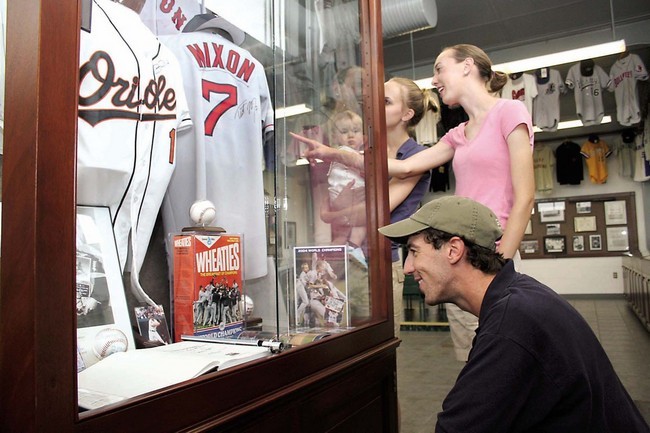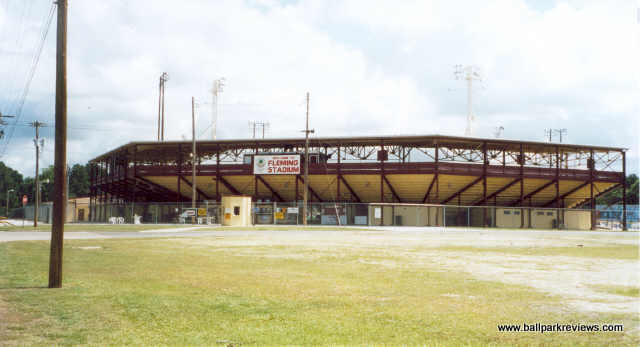North Carolina Baseball Museum
Although it does not have its own Major League team, North Carolina has a rich baseball legacy and its own Field of Dreams – Fleming Stadium in Wilson. With a 3,000 seat capacity, it hosted several Minor League Baseball teams over the decades[1], and is currently home to the Wilson Tobs, a wood-bat collegiate summer league team in the Coastal Plain League.[2] What some visitors might not know is that just inside the stadium gates, along the left field foul line is the North Carolina Baseball Museum, where you’ll find a treasure trove of artifacts and memorabilia that will melt the hearts of baseball fans young and old.
Open Thursdays through Sundays, the museum is staffed entirely by volunteers.[3] I can’t express how fortunate I was to have Eddie Boykin greet me at the entrance. The admission fee is a nominal $3.00 for people 18-65 years old but when I told him I was a lifelong baseball fan, he let me in for the kid’s fee of $1.00 with some smooth line about how I couldn’t be more than a few days over 18 anyway. I felt kinda guilty stepping into a sacred baseball site for only a buck, but I couldn’t argue with a solid guy like this.
Then, much to my surprise and delight, Eddie took me on a personal tour of the museum. The first room is devoted to Major League Players who originally hailed from North Carolina. Lining the walls are seven personal showcases for each player inducted into the Baseball Hall of Fame– Luke Appling, Enos “Country” Slaughter, Rick Ferrell, Jim “Catfish” Hunter, Gaylord Perry, Hoyt Wilheim, and Buck Leonard. Mr. Boykin pointed out that Leonard was known as “the Black Lou Gehrig.” He played for both the Negro and Mexican Leagues and was offered a Major League contract in 1952 but turned it down because he thought at the age of 45, he was too old, and was likely to injure and/or embarrass himself, thereby hurting the cause of integration.[4]
The cases in the center of the room display mementos such as autographed baseballs, news articles, photographs, and vintage trading cards honoring a collective cadre of over 400 North Carolina native sons who spent some time in the Major Leagues – from current notables such as 5-time All-Star and 2010 ALCS MVP Josh Hamilton and 2014 World Series MVP Madison Bumgarner to old-timers like Archibald “Moonlight” Graham, who made only one appearance on a Major League playing field in 1905 and would have faded into oblivion had he not emerged into the American consciousness in the 1989 film Field of Dreams.[5] “Oh yes, Moonlight Graham was a real guy,” Mr. Boykin told me as if he’d known him all his life, “and he really was a medical doctor and his wife’s favorite color really was blue, just like in the movie.” And I, always the eternal skeptic, ate it all up like Winnie-the-Pooh eats honey. This guy could have told me they played baseball on Mars and I would have believed him.
The second room features a conglomeration of local baseball history that should be commended for recognizing the accomplishments of high school and collegiate athletes as well as the pros. What stands out immediately about this room is its remarkable tactile component – you’re invited to hold a hand-carved wooden bat [6]and collared woolen uniform from the 1800s and sit down in a row of wooden seats removed from Fleming Stadium during renovations. Mr. Boykin pointed out the section on women in baseball as well as the showcases of celebrated athletes who had played at Fleming Field, such as Rod Carew (who used to play in the Carolina League), Johnny Bench,Trot Nixon, and 2011 AL MVP and Cy Young winner Justin Verlander (who used to play for the Wilson Tobs).
Of course, there’s a display commemorating a particularly exciting day at Fleming Stadium in 1956 when an MLB exhibition game was held between the Boston Red Sox and the Philadelphia Phillies. Who wouldn’t want to see Hall of Famers Ted Williams, Richie Ashburn, and Robin Roberts hanging out on your hometown field? People still talk about how the neighborhood kids lined up early to watch Ted Williams take batting practice.[7] As a Pennsylvania native and Native American cultural history enthusiast, I was thrilled when Mr. Boykin told me that Jim Thorpe[8] had played at Fleming Stadium and directed me to the corner where his memorabilia was displayed. Touching his uniform gave me goosebumps.
As I was about to leave the museum, Mr. Boykin gave me a bracelet made by a local resident strung from red and blue beads with white baseballs intermingled throughout. I offered to pay for it, but again, he wouldn’t let me. He encouraged me to stay for the Tobs game and check out the BBQ cook-off fundraiser beforehand, which I was tempted to do, and probably would have done had not the clouds darkened the sky overhead, threatening the imminence of thunderstorms.
Yes, it would have been wonderful to watch the Wilson Tobs play wearing my red-white-and-blue baseball bracelet at Fleming Stadium, where families from Wilson and neighboring communities go to spend summer evenings together enjoying America’s Favorite Pastime. And there couldn’t be a more perfect setting for the North Carolina Baseball Museum collection. An architectural marvel with landscaped terraces, grand entryway, and polished marble floors wouldn’t do it justice. Each ballpark is believed to have a soul that’s an amalgamation of the souls of all the players and fans that have co-mingled over the years like drops of water in an ocean. The strength of that soul is dependent upon fan support.[9] Fleming Stadium is where the soul of North Carolina baseball resides and that soul infuses this precious museum collection, which was amassed in large part by local citizens.[10] You can find their names engraved on the brick “Walk of Fame” leading up to the museum entrance. Wiping a tear out of the corner of my eye, I offered them my sincere gratitude and jumped into my car just before the sky opened up and poured buckets of rain down upon Wilson. A few hours later, the sun pushed back the clouds and a rainbow appeared just in time for the Tobs game to start.
[1] During its Carolina League days, Fleming Stadium was home to the Minnesota Twins/Washington Senators for 10 years and the Baltimore Orioles, Pittsburgh Pirates, and Philadelphia Phillies for 1 year, respectively.
[2] The name Tobs is short for Tobaconnists, which makes sense considering that Wilson’s economy revolved around the tobacco industry for decades and is currently in the process of reinventing itself. For a schedule of Wilson Tobs games, see https://www.wilsontobs.com/sports/bsb/2017-18/schedule. For more about the history of Fleming Stadium, see https://www.wilsontobs.com/fleming-stadium/History
[3] For more details on hours of operation and directions to the North Carolina Baseball Museum, see http://ncbaseballmuseum.com
[4] Buck Leonard was inducted into the Baseball Hall of Fame in 1972. Sporting News ranked him No. 47 out of the 100 best baseball players.
[5] The character of “Moonlight Graham” was Burt Lancaster’s final role and was largely based on real life ball player turned physician Archibald Graham, save for a few minor details changed for artistic reasons. See https://en.wikipedia.org/wiki/Field_of_Dreams
[6] In the earliest days of baseball, they used sticks to hit the ball. Eventually, players started whittling their own bats. There was no restriction on size, shape, or what kind of wood you could use until 1859, when the first regulations were put in place. For more information, see Bernie Mussill's delightful piece on the evolution of the baseball bat at Steve Orinick's umpire resource site. http://www.stevetheump.com/Bat_History.htm
[7] Well, wouldn’t you? He played Major League ball from 139 until 1960, with interruptions only for service time in WWII and the Korean War. He finished his playing career with a .344 batting average, 521 home runs, and a .482 on-base percentage, the highest of all time. That’s some badass dude!
[8] Where didn’t Jim Thorpe play? And was there a sport at which he didn’t excel? If you don’t know who Thorpe was, look him up. Seriously. Arguably the most superhumanly talented athlete ever to walk the earth. https://www.biography.com/people/jim-thorpe-9507017
[9]Scott Hunsicker, GM of the Fightin’ Phils, a Minor League team from Reading, PA, expressed this ethos perfectly when he said this of FirstEnergy Field, aka America’s Classic Ballpark: “There is a soul to this ballpark, a soul built on hosting three generations, all sharing great times, in the same great place. This stadium is an important part of the history of Minor League Baseball, an authentic piece of Americana, and we are blessed that fans from near and far make a pilgrimage here to FirstEnergy Stadium each summer to experience it, and to share it with their kids.”
[10] For more about the “cherished tradition” of baseball in Wilson and the individuals who founded the North Carolina Baseball Museum, see travel writer Lynn Seldon’s article at: http://lynnseldon.com/article705.html


